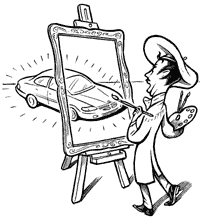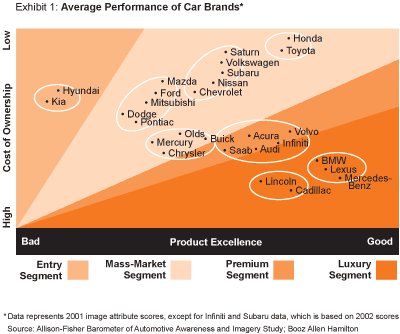Reality Is Perception: The Truth about Car Brands
Expensive advertising cannot compensate for weak brands and undifferentiated products.
 |
|
Illustration by Lars Leetaru |
Yet despite intense interest in their power, automotive brands remain relatively poorly understood. Why do car brands have such value in a business that is clearly product driven? How do brands acquire their value? What causes their value to wax or wane over time?
Because of the prominent role that brand positioning and development play in many auto manufacturers’ business strategies, we conducted extensive research and analysis to better understand how consumers think about car brands. Our analysis uses standard statistical techniques to distill multiple brand image attributes (drawn from Allison-Fisher International LLC surveys of car buyers) into a small set of underlying factors, which provide valuable insights into consumer brand perceptions. (See "Research Methodology" at the end of this article)
Our research shows that consumers have a simple yet sophisticated understanding of what differentiates car brands. Notwithstanding automakers’ attempts to distinguish their brands on the basis of lifestyle or emotional imagery, consumers evaluate brands in terms of their earned reputation for product excellence relative to their total ownership cost. Consumers’ perceptions are based on their accumulated direct and indirect experience with the products that constitute those brands.
These perceptions are obviously not perfect. Some brands’ reputations exceed or fall short of their demonstrable product attributes. But, as a rule, consumers’ beliefs are accurate, stable, and relatively immune to manipulation. In contrast to the situation with other consumer goods, in which equity is created substantially through advertising, automotive brand perceptions change primarily through consistent and sustained changes in the underlying product portfolio.
Within this overarching conclusion, we were able to identify five central insights that are critical to understanding how, and to what extent, manufacturers can enhance and leverage the value of their brands.
1. Virtually all of the difference in how consumers perceive competing brands can be explained by their relative performance against two holistic measures: product excellence and cost.
Traditionally, car manufacturers have tried to measure their brands across a large number of image attributes, hoping to develop additional insights about brand differentiation. However, consumer perceptions of a brand’s reputation are generally consistent across different measures of value. For example, consumers believe that manufacturers whose car lines have a reputation for luxury and prestige tend to produce cars that excel in many other areas, such as ride, handling, safety, and reliability. In fact, a brand’s score on any one attribute tends to be so highly correlated with its score on another attribute that these scores can be integrated into one measure that represents a car line’s propensity to create excellent products.
Consumers also have a sophisticated understanding of product cost. They recognize that vehicles differ not only in their initial purchase price, but also in their expected maintenance and operating costs, as well as their ultimate resale value. Together, these different types of expenditures determine the total cost to the consumer over the ownership cycle. As with the product excellence dimension, the various attributes that determine a brand’s expected ownership costs can be integrated into a single measure of product cost.
These two holistic measures, product excellence and cost of ownership, account for 91 percent of the difference in how consumers perceive automotive brands. (See Exhibit 1.) In fact, these two holistic measures are comprehensive enough to predict the consumers’ overall opinion of the brand with an extremely high degree of accuracy.
Of the remaining variation in consumer perceptions, roughly half (or 5 percent) is due to specific attributes such as “sporty.” These secondary attributes are not highly correlated with other attributes and cannot be included in the holistic measure of product excellence. With the exception of a few outliers (for example, BMW, whose reputation rests in part on its sportiness), most brands tend to be relatively undifferentiated along these secondary attributes.
2. Consumers are not only elegantly simple in their view of automotive brands, they are acutely rational as well.
For the average consumer, a new car is second only to a new home in the size of the transaction, the length of the ownership cycle, and the potential to reaffirm and communicate an individual’s sense of self-worth. Consequently, consumers spend a substantial amount of time evaluating their alternatives. In addition to their own firsthand experience, they consult a number of sources, from the anecdotal evidence of friends and family, to independent reviews by magazines, industry groups, and government agencies, to the manufacturers’ marketing communications, including brochures, measured media, and owner events.
It’s true that some brand reputations, particularly in the mass-market segment, don’t keep lockstep pace with actual changes in the products. But in general, consumers are well informed, and their opinions accurately reflect the accumulated performance of the products that are the physical embodiment of those brands. For example, the cost-of-ownership brand measure is highly correlated with actual cost of ownership. Similarly, consumers’ perceptions of a brand’s reputation for durability, reliability, and workmanship (which are key constituents of the holistic product excellence measure) are highly correlated with the actual dependability of that brand’s vehicles.
3. The relative magnitude of product excellence and low cost of ownership determines a brand’s value proposition in the marketplace.
Consumers recognize that, in general, better products cost more. Consumers self-select an automotive segment on the basis of which attribute (cost of ownership or product excellence) they value more. Within a consumer’s chosen segment, brands that deliver more of both attributes provide superior value to the consumer.
As a result, brands can differentiate themselves in two fundamental ways: by providing a different proportion of product excellence to cost of ownership (i.e., segment selection); and by providing more or less performance across both attributes (within the boundaries of the chosen segment). The result is a production function that’s a classic trade-off between product excellence and cost of ownership, with the frontier defined by brands providing the most value in each segment.
It is possible to group brands using statistical clustering techniques, so that grouping definitions minimize the differences within clusters and maximize the differences between clusters. These clusters represent groupings of brands that consumers believe offer comparable amounts of product excellence and low cost of ownership. Consumers perceive that brands in a cluster offer a value proposition similar to those of other brands in the same cluster and materially different from those in different clusters.
This is not to argue that brands within the same cluster are identical. Brands can partially differentiate themselves on the basis of secondary attributes. BMW has carved a niche within the luxury segment based on its image as the “ultimate driving machine” that offers superior acceleration, turning, and handling. Likewise, Subaru has partially differentiated its reputation within the mass-market segment on the basis of the security of all-wheel drive.
Channel performance (e.g., dealership experience and product availability) can also be used to differentiate a brand. Saturn stands out for having good customer service and providing a pleasant buying experience. However, the majority of brands are not meaningfully differentiated on any basis other than product excellence and cost of ownership.
4. Brands in crowded, weakly positioned clusters tend to suffer from eroding margins.
Brands positioned closer to the lower left-hand corner of Exhibit 1 (i.e., those with higher cost of ownership and lower product excellence) offer less value to consumers. Such brands naturally tend to achieve lower purchase consideration and hence volume. A large number of such brands within the mass-market segment are competitively disadvantaged relative to other brands within the same segment and relative to brands in neighboring segments, as Exhibit 1 shows.

For vehicle manufacturers with large capital investments, this situation is untenable. They must seek to improve at least one of the two holistic brand measures for their brands. Because improvement of a brand’s product excellence is difficult to accomplish across an entire product portfolio and generally requires up to a decade, the only way for brands to improve their positioning quickly is to lower product prices and offer customers better cost of ownership.
By contrast, Honda and Toyota have clearly distanced themselves from the rest of the mass-market segment. In the consumer’s mind, Honda and Toyota represent a combination of product excellence and cost of ownership that so far surpasses all other competitors that they operate along a different trade-off curve. While not yet in the same league, several other brands, such as Volkswagen, Saturn, and Subaru, have also separated themselves from the rest of the pack.
5. Brand positions tend to change relatively little over time.
Consumer perceptions are shaped in large part through accumulated product experience, both firsthand and indirect. Consumers also use a large number of objective sources of information to supplement their direct product experience (e.g., word of mouth, product reviews, and safety ratings). As a result, the perception-forming process is long and relatively immune to simple manipulation by the manufacturer, in contrast with most consumer goods, whose brand equity is created substantially through advertising.
Although marketing communications certainly play an important role in what consumers think, the only way to sustain meaningful change in automotive brand perceptions is with ongoing, consistent changes in the underlying product experience. Furthermore, since brand value is a function of performance relative to the brand’s competition, significantly altering brand perceptions requires a manufacturer to systematically improve its entire product range faster than its competitors do.
Over the past two decades, most manufacturers have made concerted efforts to improve product quality, develop new features, and reduce costs. They have used various techniques, such as computer-aided design, system outsourcing, and component reuse, to speed up the product development cycle, reducing the time it takes to respond to competitors’ innovations. As a result, it is increasingly difficult for manufacturers to improve their products continuously at a rate that outpaces the market.
Doing so requires a coordinated strategy and a concerted effort. In the late 1990s, Volkswagen deployed a steady stream of new products to significantly shift consumer perceptions of its brand. VW leveraged product and process technologies that had been developed for Audi in such areas as engine packaging, powertrain, chassis tuning, advanced material forming, and tight tolerance assembly. The result was a slate of products, including the Jetta, Passat, and New Beetle, that offered superior ride, handling, styling, and assembly quality at a reasonable cost. Furthermore, the migration of Audi process and product technologies to VW did not erode consumers’ perceptions of the Audi brand. However, recent reports of cross-model quality problems (e.g., ignition coil faults) could serve as the reversal point of VW’s recent brand improvement journey.
Like VW, the Hyundai and Kia brands have benefited from a sustained flow of new products that offer significantly improved quality, attractiveness, edgy styling (at times), and extremely low cost of ownership due to low sticker prices and extended warranty coverage. The resulting value proposition has not only increased these brands’ unit volume, but also has radically changed consumers’ perceptions of the brands. What is stunning is how much the Korean brands have improved in such a short time, especially in comparison with how long it took Toyota and Honda to shake their reputation for producing tin cans. If the Korean brands continue to improve their reputation for product excellence while maintaining their cost of ownership, they could leapfrog the Big Three mass-market brands to join the cluster currently defined by VW, Nissan, and Saturn.
In contrast, the value of Saturn’s brand has been deteriorating. Saturn was initially able to transfer consumers’ satisfaction with the dealer experience to the product. Although Saturn still remains differentiated on the basis of its channel performance, the product has failed to satisfy consumers’ expectations for quality, and the brand as a whole has experienced significant erosion.
Like Saturn, the Buick, Oldsmobile, and Mercury brands demonstrate the impact that a consistently weak product line has on brand value. In their heyday, Buick and Oldsmobile represented the quintessential premium brands — steps above Chevrolet and only a notch or two below Cadillac. Several generations of product that were rebadged versions of mass-market vehicles, and the growth in market penetration of alternatives such as Volvo and, more recently, Audi, undermined the value position of the Buick, Oldsmobile, and Mercury brands.
Mercedes-Benz and BMW have both delivered significant improvements in cost of ownership over the past decade. In part, this was caused by direct pricing pressure from Japanese luxury brands (most notably Lexus). However, we believe a large portion of the difference is due to a change in product mix to include more entry-level luxury vehicles (e.g., BMW’s 3 series and Mercedes’s C-class). As these brands have shifted their center of mass toward “entry luxury,” so has consumer opinion shifted.
Marketer’s Checklist
Few manufacturers have the resources required to implement such a sweeping overhaul of their product portfolio. Consequently, brand positions tend to change relatively little over time. Furthermore, it is far easier to erode brand equity than it is to build brand equity. Product missteps, gaps in the product pipeline, and intentional efforts to shift a brand’s customer base can lead to significant deterioration in brand value.
The five findings detailed above have profound implications for most manufacturers.
- Tangible product differentiation is both critical to success and difficult to maintain on a sustained basis. A key focus of the marketing function should be to rigorously understand consumers’ preferences, unmet needs, and willingness to pay, in order to maximize the “hit rate” on innovative products.
- Minimizing cost of ownership (both up-front acquisition cost and long-term ownership cost) within the segment boundary is critical. The marketing function must take an active role in balancing the drive toward lower cost of ownership with the consumer value created through innovative features and options.
- Lifestyle and emotional imagery cannot compensate for weak brands and undifferentiated products. Consumers may acknowledge a brand’s “personality,” but the aspects of the brand that drive consumer shopping behavior are promises that the brand represents for product excellence and cost of ownership. Image advertising and lifestyle and event marketing may help to accelerate consumers’ understanding of the brand, but it cannot fundamentally change the promise. Consequently, the number of resources applied toward lifestyle and image advertising should be scrutinized for appropriateness and effectiveness.
- For mass-market vehicles, incentives are a symptom of a weak brand — not the cause. In the absence of a strong brand, price is the only plausible way to affect near-term demand. Hence, curtailing incentives in an effort to “build brand” is not likely an economically viable option.
Many manufacturers have made brand positioning and development a key item on their marketing agenda. Yet brands are not the product of manufacturers’ marketing efforts. Instead, consumers base their understanding of an automotive brand’s value on their accumulated experience with that brand’s products. If you want to change the brand, change the products — for the better. ![]()
Reprint No. 03302
|
Research Methodology |
|
Our research is based on data from the Allison-Fisher Barometer of Automotive Awareness and Imagery Study (the primary source is the “Car Makes” study, which is supplemented with the “Light Vehicle” study to include Saab and Infiniti). The research and conclusions are specifically for cars. Allison-Fisher surveys car buyers on their attitudes, focusing on 24 specific attributes: excellent handling, excellent ride, excellent workmanship, good looking, good warranty program, good customer service, good safety for occupants, high trade-in value, prestigious, luxurious, really dependable, sporty, technically advanced, fun to drive, excellent acceleration, lasts a long time, name you can trust, viewed as a leader, satisfying sales experience, trend-setting vehicles, economical to operate, excellent gas mileage, good value for the money, reasonably priced. We employed standard statistical analysis (factor analysis) to identify which of these image attributes correlate with each other and to distill the 24 attributes down to a small set of underlying, uncorrelated factors, or “meta-attributes.” Attributes with a 60 percent correlation were considered part of the same factor. Two underlying meta-attributes emerged from this distillation: product excellence and cost of ownership. In order to further validate the dual meta-attribute model, we employed standard regression analysis techniques to demonstrate the meta-attributes’ ability to predict brand opinion. The results confirmed the model and demonstrate very strong predictive power (R2=96%) for the model. After identifying the two factors and determining each brand’s scores on the two meta-attributes, we detected clusters of brands. These clusters not only match our intuition of how the automotive market is segmented, but are statistically valid (based on cluster analysis, another standard statistical technique). To study how brands have changed over time, we looked at historical image attribute data, limiting ourselves to the subset of image attributes that were consistently available across the entire past decade. The original analyses (factor analysis and clustering) were repeated on this subset of image attributes and conducted on the full decade-long set of data. Brand position evolution was then studied to see which brands showed both significant (i.e., large magnitude relative to others) and consistent (i.e., same year-to-year trend) movement. |
Evan Hirsh (hirsh_evan@bah.com) is a vice president of Booz Allen Hamilton based in Cleveland. He specializes in strategic marketing, business unit strategy, and performance improvement for consumer and industrial companies. Mr. Hirsh is coauthor, with Steven Wheeler, of Channel Champions: How Leading Companies Build New Strategies to Serve Customers (strategy+business/Jossey-Bass, 1999).
Steve Hedlund (shedlund@moen.com) is a vice president of strategic planning and new business development for Fortune Brands Inc. Previously, he was a principal with Booz Allen Hamilton, focusing on organizational and strategy-based transformation for automotive, aerospace, and industrial companies
Mark Schweizer (schweizer_mark@bah.com) is a senior associate in Booz Allen Hamilton’s Cleveland office. He focuses on product, sales, and marketing strategy for automotive OEMs and suppliers.



